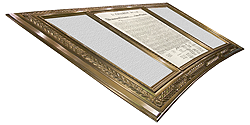 Situation
Situation
The Rotunda of the National Archives Museum is the final resting place of the Declaration of Independence, one of our nation’s most treasured documents. Over time, the unique hand-crafted frame has become worn down, leaving its intricacies muted and details eroded.
Manufacturing at the turn of the century was mostly done by hand, therefore there is no record of the original design from 1924. Several attempts were made to recreate the frame using conventional bronze sculpting techniques. The results however did not meet the standards of the National Archives and Records Administration.
The IGES looks great! Thanks for the quick turn-around. I might have another scan job for you to look over soon.”
3DScanCo — a division of Laser Design Inc — was contracted to make a final attempt at the frame’s restoration. Pioneering new techniques in combining 3D scanning with digital restoration, 3DScanCo was successful in recreating and restoring the frame. By utilizing 3D scanning technologies, 3DScanCo reworked the patterns and details digitally without risking damage to the one-of-a-kind frame.
3DScanCo enhanced the faded features such as the leaf patterns, the stem, the flowers, and the seeds. The bronze medallions were recreated with a rounder look to fit the newly curved frame shape. After exceeding expectations, the data was sent to Valley Bronze, the casting company, for manufacturing.
 Results
Results
The National Archives Museum went though two different companies in five years trying to restore the frame. Neither company was successful. 3DScanCo successfully and impressively completed the project, supplying Valley Bronze with CAD data that would be used to manufacture a fully restored frame.
The National Archives Museum has already commissioned 3DScanCo to help restore the frames of the Constitution and the American Originals exhibit, trusting in 3DScanCo’s ability to supply the highest quality 3D scanning services

